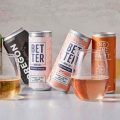DO YOU KNOW HOW MUCH CANNED ENERGY DRINK YOU CAN DRINK PER DAY?
Energy drinks became known almost four decades ago in association with extreme sports, when Red Bull began sponsoring extreme sporting events. It is now young people, teenagers and pre-teens who are the most enthusiastic consumers.
Already in 2018, the UK banned the sale of these drinks in supermarkets under the age of sixteen. However, this type of beverage is currently one of the most widely consumed sources of caffeine. This industry is expected to grow by a further 7% by 2025. Although the exact formulation changes from brand to brand, energy drinks generally contain carbonated water, sugar or other sweeteners, B vitamins, added flavourings and colourings, caffeine and other associated energy supplements such as taurine, guarana or ginseng.
According to the OCU, the abuse of this type of drinks, especially by teenagers, implies a real risk. Nowadays, the variety of energy drink brands is very wide. Alongside the pioneering brands, such as Red Bull and Monster, many others have appeared: Atlantis, Beebad, Burn, Crazy Tiger, Eneryety, Missile, Nocco, Rodeo, Reign, Rockstar and Yula. These are joined by energy varieties of Coca-Cola (Coca-Cola Energy and Coca-Cola with coffee). In addition, the vast majority of supermarket brands have joined this trend and each one has its own Energy drink product.
These drinks therefore contain caffeine, which is a central nervous system stimulant, in moderate doses increases alertness and reduces drowsiness. In addition, some incorporate B vitamins and amino acids and substances that are attributed with energizing or revitalizing effects, such as:
Ginseng: it is a plant that has been used for medicinal purposes, as a remedy against asthenia and physical and mental exhaustion.
Taurine: is an amino acid produced naturally by the human body and is found in foods such as meat and seafood. It is essential for the cardiovascular system, the central nervous system and for the normal functioning of skeletal muscle. It is associated with an increase in athletic performance and endurance.
Glucuronolactone: the body produces it naturally from glucose, although the glucose in drinks is obtained in a laboratory. Anti-fatigue and stimulating effects are attributed to it. According to EFSA (European Food Safety Authority), the concentrations of this compound used in energy drinks do not pose a risk to the consumer.
Guarana: Amazonian plant that contains stimulants such as caffeine. It is supposed to have energizing and slimming effects. To date, EFSA has not approved any claims related to the effects attributed to these substances.
The risk of drinking too much caffeine
Consumed in moderate doses, caffeine increases alertness and reduces drowsiness. But too much also has its risks. In the short term, it causes problems related to the central nervous system, such as disrupted sleep, anxiety and changes in behavior.
In the long term, its consumption has been linked to cardiovascular problems and, in pregnant women, to fetal growth retardation. Excessive use can have consequences such as increased blood pressure, increased heart rate and even decreased cerebral blood flow. For people with high blood pressure, it is advisable to moderate its consumption.
The World Health Organization (WHO) itself supports this theory. In 2014 he already warned that the increase in the consumption of energy drinks can represent a danger to public health, especially among young people.
Amounts that should not be exceeded
EFSA has established references for safe caffeine intake, which differ for adults, pregnant women, children and adolescents, and depending on whether caffeine is taken as a single dose or spread throughout the day.
For the general healthy adult population, intakes of up to 400 mg of caffeine consumed throughout the day have no detrimental health effects. It is estimated to be around 5.7 mg per kg of body weight; for example, for a 60 kg person, the safe amount would be 342 mg per day.
For pregnant or breastfeeding women, intakes of up to 200 mg consumed throughout the day have no harmful effects on the health of the foetus. In a single dose, up to 200 mg of caffeine is considered safe, at a rate of about 3 mg per kilogram of body weight in both adults (non-pregnant) and children and young people. In the case of a teenager weighing about 50 kg, the maximum safe amount would be 150 mg.
Can we consume energy drinks on a daily basis without negative consequences?
According to the study published by the European Journal of Nutrition, its excessive consumption can cause an increase in blood pressure, an increase in heart rate and a decrease in cerebral blood flow. In addition, these drinks can also cause kidney damage due to the high concentration of caffeine.
A caffeine that in doses higher than 500 milligrams produces many other negative effects such as “nervousness, perspiration, anxiety, excitement, irritability, nausea, paresteasis, tremors, palpitations, restlessness and possibly dizziness. This is one of the main reasons why teenagers, and especially children, are more likely to suffer from the negative side effects of energy drinks.
What happens if energy drinks and alcohol are mixed?
In 2013, EFSA published the results of the assessment of the risk associated with the consumption of energy drinks combined with alcohol. Alcohol consumption at doses up to 0.65 g/kg body weight would not affect the safety of single doses of caffeine up to 200 mg. Up to these levels of intake, it is difficult for caffeine to mask the subjective perception of alcohol intoxication.
However, as the WHO warned a year later, the problem arises when these amounts of alcohol or caffeine are exceeded, which is not uncommon among teenagers who mix large amounts of alcohol and energy drinks when they go out partying. An adolescent (50 kg) would exceed 0.65 g/kg weight with a couple of glasses.
The danger of mixing energy drinks with alcohol is that the large amounts of caffeine reduce sleepiness and tiredness, but do not reduce the effects of alcohol, resulting in what is known as the state of ‘drunken awakening’.













